Delphinium: seed growing technology
Unopened flowers delphinium look like little dolphins. Perhaps this explains their name. The homeland of the delphinium is the southeast of Asia. More than 400 varieties are known, both annual (40 species) and perennial. This also includes the related genus of scabbard.
Content:
- Delphinium: description
- Seed collection
- Seed preparation
- Sowing seeds
- Planting seedlings
- Seedling care
- Pests and diseases
Delphinium: description
Delphinium has other names - spur, larkspur, lark legs, knightly spurs. This plant belongs to the buttercup family. There are undersized (from 20 to 120 cm), medium (up to 150 cm) and tall. Some specimens can reach a height of 4 m.
The leaves are palmate-divided or finger-dissected. The flower is composed of five bright sepals. In the center there are two nectaries in the form of a petal and a staminode (a leaf colored in a different color). Staminodes are called ocelli. They attract bumblebees to the flower for pollination.
Flowers of all shades of blue, purple, pink, red and white, with spots, spur.
There are varieties with double and semi-double flowers. The size of one is from 3 to 5 cm. They are collected in inflorescences with spikes up to 10 cm long. Fruits - leaflets contain seeds arranged in two rows along the seams. In varieties with simple flowers, they are usually 3, and in double flowers - from 4 to 8. Seeds from such plants are used to grow large-flowered plants. Roots for the majority delphinium racemose. They can withstand frosts down to -50 ° C. But he does not like sudden changes in temperature.
Reproduction of annual delphiniums occurs seeds... For perennials, reproduction is more often used. dividing the bush, cuttings... Seed propagation is also used, although compared to other methods it is much longer. It can grow in one place for several decades. But this happens in the case of self-seeding of plants.
Seed collection
Hybrid varieties should not be propagated by seeds, because young plants usually do not inherit the characteristics of the mother. For reproduction of such varieties, dividing a bush or buds, cuttings are used.
Delphinium Seeds can be harvested from nearby bushes. In order for them to be of high quality and have good germination, the following conditions must be met:
- Collect ripe seeds.
- Collect seeds in dry weather.
If the fruits are cracked and the seeds can spill out of them, cut off after they turn brown. Unripe fruits are brought to the desired state in a dry, ventilated place where the wind does not blow.
Seed preparation
Typically, delphinium seeds are sown at the end of February. But before that, they should not be stored in a dry and high temperature room, but in a refrigerator or cool room. The maximum term for germination of seeds stored under normal conditions is 11 months from the time of ripening. To prolong it, place the seeds in the refrigerator. There they do not lose their germination for several years.
Features of seed preparation:
- Before sowing, they must be treated with a solution of potassium permanganate of medium concentration. So that they are not lost, they are placed in a gauze bag. The disinfection time is 20 minutes.
- Then the seeds are washed without removing them from the gauze and placed in a glass of water, to which a few drops of the epin biostimulant are added. You need half a glass of water. The seeds are kept in it throughout the day. Then they are taken out and dried.
There is another way seed stratification delphinium:
- Pieces of light cotton fabric are cut into rectangles.
- Seeds are poured on it in a "path" so that it is in the center of the rectangle.
- Wrap the ends of a piece of fabric and gently roll it into a roll. The seeds should not budge significantly.
- Water is poured into the bottom of the dishes, rolls of seeds are placed in it. The water should not cover them, but only rise by the capillary pathway, moisturizing the fabric.
- Place the dishes in a refrigerator or cellar with a temperature of about 5 ° C.
You can moisten delphinium seeds with sphagnum moss. It is soaked in water and the prepared rolls are wrapped. Placed in a bowl and sent to a cold place. As a result of this procedure, the seeds should swell, but they should not have roots. The fact that they will appear soon is indicated by light spots on the seeds.
Sowing seeds
Prepare boxes, fill them with soil prepared from turf, peat and humus. These components are taken in equal parts. Washed coarse sand (half part) is added. Good results are obtained by adding agroperlite to the soil (a glass of 10 liters of soil mixture). The soil will become loose, it will be better to retain moisture, gradually giving it to the plants.
The finished mixture is heated in a water bath for 1 hour. At the same time, weed plants and pathogens of fungal diseases die. They lay the soil, constantly compacting.
Seed sowing rules:
- The seeds of the delphinium are small, so they need to be embedded in the soil shallowly. Spread the seeds evenly on the ground.
- Sprinkle on top with a layer of cooked earth up to 3 cm high, tamp it slightly, only then watered. Water is used boiled cooled to room temperature. At the same time, the seeds do not float to the surface, remaining under the soil layer. Place labels on which the name of the variety and the date of sowing are written.
- Cover the boxes with glass, on top - with a dense dark film that does not transmit light rays. Delphinium seeds germinate better in the dark.
- The boxes are kept at a temperature of 12 to 15 degrees. You can install them on windows where the temperature is usually slightly lower than in the room. The maximum germination rate will be in those boxes that were placed on the balcony or in the refrigerator for 3 days. The room temperature should not be lower than 5 degrees below zero. Stratification can be done prior to sowing. In this case, the moistened prepared seeds are placed in the refrigerator for 3-4 days, then sown.
- After 7-14 days, sprouts appear. They are watered carefully. The dark film is removed. The boxes are installed in a lighted place so that the sprouts do not stretch out. Every day the plants are ventilated, shaking off the condensation.
A month after the appearance of seedlings, when they have formed 2-3 leaves, they are transplanted, breaking off the lower part of the root (dive). It promotes ramification root system... The distance between the plants should be about 4 cm. It is better to transplant the seedlings into separate pots. Grown at a temperature not exceeding 20 degrees, periodically placed in fresh air. This will allow the plants to harden and prepare for outdoor cultivation.
Water it periodically, but waterlogging should not be allowed. It can lead to a black-footed injury that causes plants to fall to the ground and die. When small delphiniums get stronger and begin to release new leaves, they are fed at intervals of 2 weeks. Use "Solution". Do not pour the solution onto the leaves. Over time, the roots of the plant grow, penetrating all the potted soil. Usually by this time they are planted in a permanent place.
Seeds of non-varietal delphinium varieties can be sown directly into the ground.
This is usually done when it is not possible to create the necessary storage conditions for them. To do this, in October or November, they dig shallow grooves, sow seeds in them. Sprinkle with earth and cover with a layer of spruce branches or dry leaves. You can sow even before winter, when the ground is frozen. But for this, you need to prepare the grooves and soil in advance in order to sprinkle the seeds. Shelter until spring. After the shoots appear, the branches are removed.
Planting seedlings
Delphinium loves lighted areas. But in order for its flowers to be as bright as possible, it must be planted in partial shade. In the first half of the day, the site should be well lit, then branches of other plants will cover it. The site must be sheltered from the wind. This is due to the fact that the delphinium stems are tall and thin. Gusts of strong wind can break them.
To grow a delphinium, you need nutritious soil, loamy or sandy loam. Delphinium does not like acidic soils. In this case, they need to be limed. Particular attention must be paid to the structure of the soil. It does not have to hold onto water so that the roots of the plant do not rot. Therefore, under
You can plant young plants in a permanent place from May to August.
The distance between plants depends on the height of the variety and can be up to 70 cm.Pits are prepared with a depth of 50 cm and a diameter of 40 cm.The soil from the pit is mixed with humus, a glass ash, 2 tbsp. spoons of complex mineral fertilizer... Mix thoroughly, put back into the pits. They are compacted so that the planted plant does not sag.
Seedlings are placed in the soil. When planting, the root collar is set at ground level. Seedlings are watered, mulched with peat, humus or ready-made compost... The thickness of the mulch layer should be at least 3 cm. Immediately after planting, glass jars or cut plastic bottles should be placed on the plants. This will create optimal conditions for the planted plants. Shelters are removed immediately after the plants grow.
Seedling care
Care Tips:
- Water the delphinium after disembarking at a permanent place at least 1 time per week. The mulch will retain moisture between waterings. For plants in the bud formation phase, up to 30 liters of water will be required at a time.
- Delphiniums need to be fed. After they take root and the shoots reach a height of 15 cm, nitrogen fertilization can be applied. Use a solution chicken or cow dung. For this, manure is bred in a ratio of 1:10 in water, kept for 10 days. Take 1 liter of the infused mixture on a bucket of water. But if the soil was well fertilized when planting, you can do without it. After the first inflorescences are formed, potash and phosphorus fertilizers are applied.
- When the bush reaches a height of 30 cm, the bush is thinned out, leaving up to 5 stems. At the same time, weak shoots are removed from the inside. This procedure improves ventilation of the bush, reduces the risk of disease. powdery mildew... The flowers on the remaining stems will be larger, and the bush itself will be more beautiful.
- When the bush grows to 50 cm, 3 pegs as tall as a person are placed around them. This should be done so as not to damage the root system. The stems are tied to them, protecting from the wind. Repeat the procedure when the plant reaches a height of 1 m.
Pests and diseases
The main pests of young delphiniums:
- Delphinium fly
- Onion fly
- Spider mite
- Nematodes (chrysanthemum, gallic, short-bodied penetrating)
- Slugs (only harm young plants)
Delphiniums are also affected by some diseases:
- Powdery mildew
- Fusarium wilting
- Annular viral spot
- Bacterial rot
- Black bacterial spot
You can fight fungal diseases by spraying fungicidesthinning bushes. Insecticides are used to control pests.
More information can be found in the video:




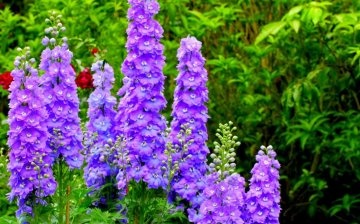
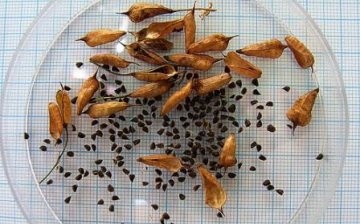
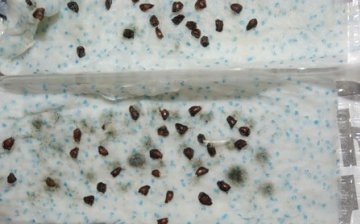
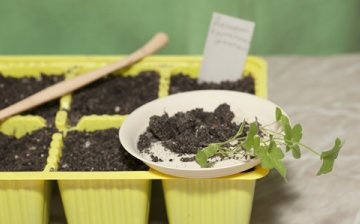
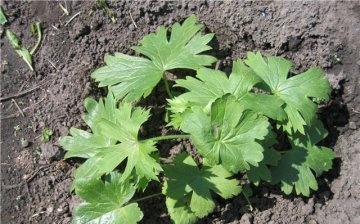
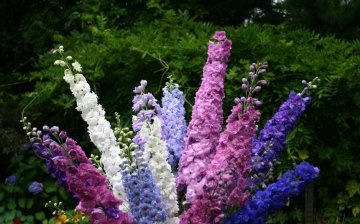
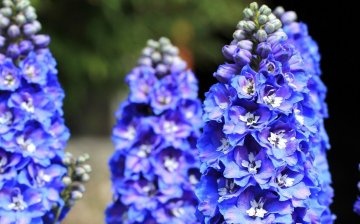









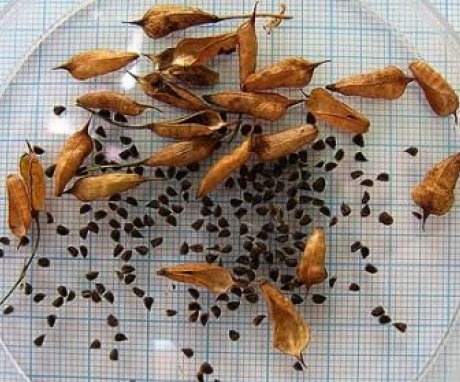
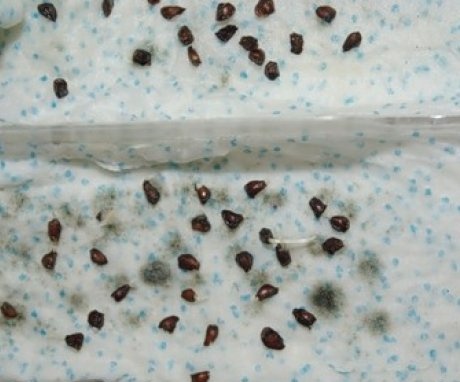
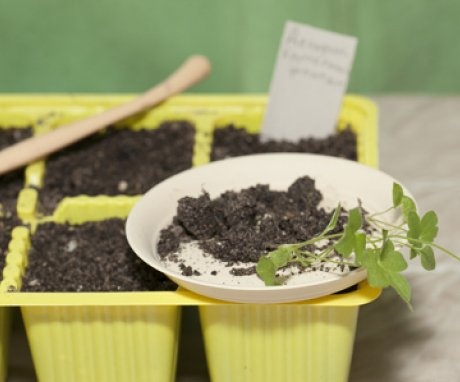

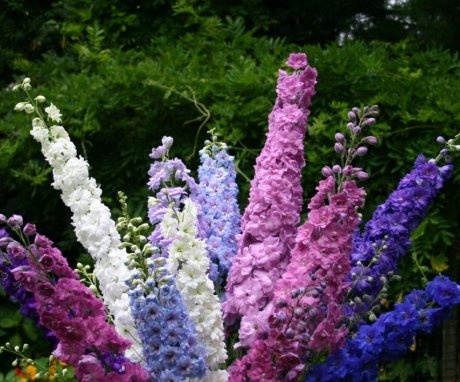
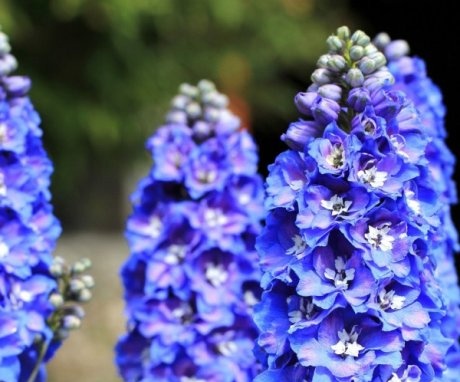
Delphinium grows with us and, perhaps, as I see, it is a very common plant for flower beds. This flower is unpretentious, quite beautiful and unobtrusive, which characterizes its popularity. As a first approximation, of course ...